New Player Guide
Posted: Tue Jan 26, 2010 5:45 am
(Cross-posted from my blog)
Table of Contents
[1] What is Ryzom?
[1a] Why This Game is Unique
[1b] Who is Ryzom's Target Audience?
[1c] Atys, the Living Planet
[1d] The Four Civilizations
[1e] The Kami and The Karavan
[2] Getting Started
[2a] Downloading the Game
[2b] Creating an Account
[2c] Configuration
[3] Character Creation
[4] The Interface
[5] How to Play
[5a] The Basics
[5b] The Ruins of Silan
[5c] The Four Skill Trees
[5d] Enemy 'Conning' System
[5e] Building Actions
[6] The Mainland
[7] Tips & Tricks
[8] Useful Links
In August 2008, new owners of the game returned the servers to life. Since that time the game has seen small developments and improvements, as well as some new external features. The game continues to survive, nurtured by the passion of its players and development team.
[1a] Why This Game is Unique
Ryzom is unique in the MMORPG market for a number of reasons. The most apparent to anyone looking at the game will be the setting; rather than a traditional fantasy or science fiction, Ryzom introduces races, creatures, and environments that are completely alien. This is both daunting and liberating, as players are expected to forget the comforts of the stories they are familiar with and embrace completely new concepts.
The game features an open-ended character development system. Player progression is not determined by a predefined class or profession, but rather by the choices the player makes in developing their skill trees. Players may choose to specialize in fighting, magic, crafting, or foraging; but to experience the game to its fullest, most will explore all four. These initial specializations divide further as a player gains skill levels, for example fighting will divide into melee and ranged fighting; melee fighting will divide into one-handed, two-handed, and close-combat specializations, and those specializations will split further into their respective weapons. There is no limit to how many skills a player can master, although mastering them all would surely be a challenge.
In addition to the skill trees, players are able to design their own skills and spells through the use of stanzas. By combining attack properties such as damage type or area of effect with costs and limits, players can effectively customize their skills to suit their play style. This is explained further in section 5e.
The game also sets itself apart through the design of its world. Atys is a planet in constant change; not only does the game cycle through the seasons, but creatures will migrate, resources will shift, and outposts will change hands. Daily life will change for players as well as the game hinges on interdependency. With the economy and the story in constant flux, a life on Atys is an ever-evolving one.
[1b] Who is Ryzom's Target Audience?
While the game may appeal to a variety of players, there is little question that in this day, Ryzom is targeted at roleplayers seeking an immersing sandbox experience. With its complex world design and free-form gameplay, as well as the ability for players to create and 'DM' their own instanced scenarios (not covered in this guide), the game should appeal to anyone looking for a deep and engaging MMORPG where imagination takes precedence over progression and status.
Ryzom also sees heavy roleplaying support from its owners, allowing players to embed themselves in the ongoing storyline of the game.
While I would not discourage anyone from trying the game, consider it fair warning that players interested in traditional treadmill games with pre-written storylines and large amounts of solo play will not find it here. An open mind and desire to experience something new will be the key to finding your enjoyment in Ryzom.
[1c] Atys, the Living Planet
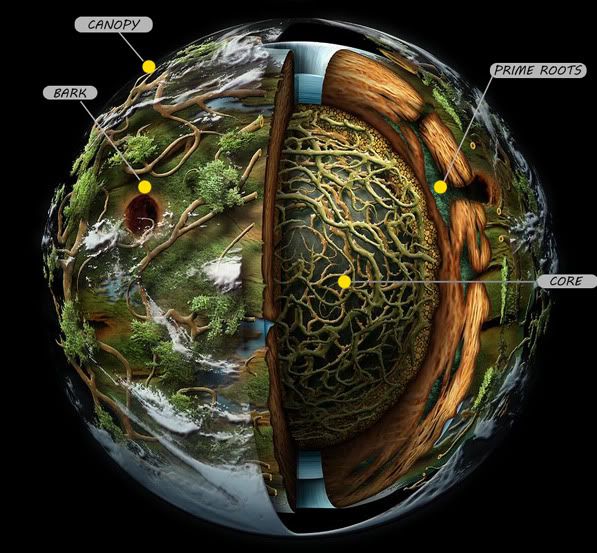
In the far reaches of space in an unknown galaxy, a lush green planet teems with life. This planet is not like those we know; it is not formed of rocks, minerals, and ore. Instead, the planet is a singular organic entity - a gargantuan tree, growing ever-outward. On the bark of this tree live the Homins, the people of Atys not unlike humans. In the skies above are the canopies; gargantuan branches extending far into the horizon. Below are the Prime Roots, the cavernous dark filled with the planet's riches. Homins must not explore too deep, lest they breach the core and incite the ferocious Kitins within.
The playable area of Atys is divided into five distinct geographical regions. On the planet's bark are the forests, the desert, the lake-lands, and the jungles. Each region is home to a native Homin civilization. Also open for exploration are the Prime Roots, where Atys's greatest challenges and treasures await.
[1d] The Four Civilizations
Players of Ryzom may choose to create a character in any of the four civilizations: Fyros, Matis, Tryker, or Zoraï. Each civilization has its own distinct culture reflected not only in their cities, but also the armor and weapons they create.
View a trailer introducing the four civilizations.

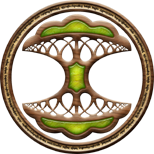
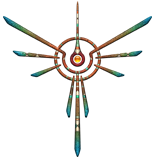
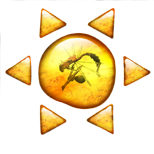
[1e] The Kami and The Karavan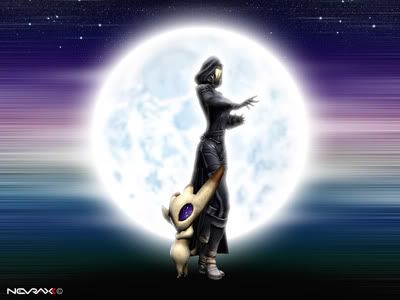
Read more about the Kami
Ryzom can be downloaded by visiting the game's website at Ryzom.com. Players have the option to download Ryzom directly, through a torrent, or through a mirror. After downloading, simply run the installation setup and follow the prompts, and you'll be ready to launch the game!

[2b] Creating an Account
Accounts can be registered at secure.ryzom.com/signup/. No credit card is necessary, and the game is free to try for 21 days. The trial has no artificial restrictions placed on it, and players may experience the full game during their trial period. After registering, players will need to confirm their accounts through the e-mail provided before logging in.
[2c] Configuration
After launching the game, players will be presented with a login screen. From here they may access the Game Configuration settings. Once the configuration page has loaded, you may change your resolution, graphical and sound settings, as well as access debugging options should you find them necessary.
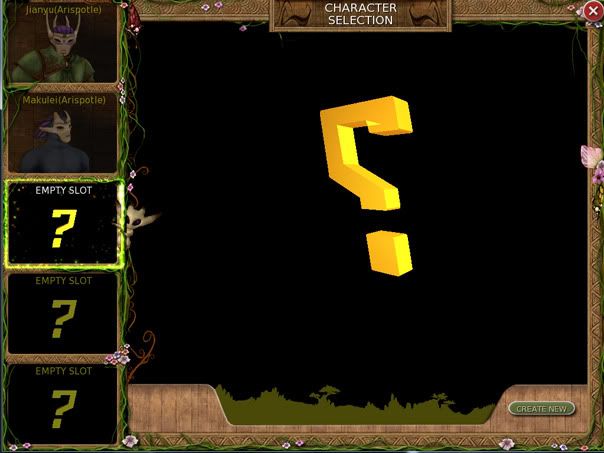 You'll then be taken to character creation, where you can begin to make your Homin. You may first choose your civilization and gender. Afterwards, you will be able to customize your body shape.
You'll then be taken to character creation, where you can begin to make your Homin. You may first choose your civilization and gender. Afterwards, you will be able to customize your body shape.
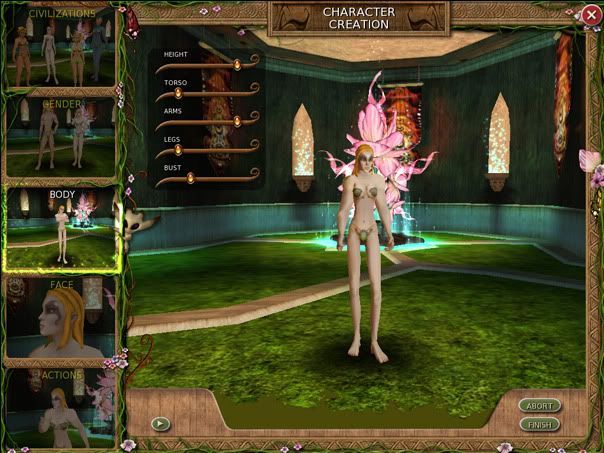 As you can see, the sliders can go to moderate extremes. Some changes are more noticeable on certain races or genders than others, but every player will be able to create an avatar between the realms of husky, slim, and muscular as they see fit.
As you can see, the sliders can go to moderate extremes. Some changes are more noticeable on certain races or genders than others, but every player will be able to create an avatar between the realms of husky, slim, and muscular as they see fit.
Facial customization is also possible. Although the basic shape of the head cannot be altered (save for the chin), the facial features may be reshaped or repositioned.
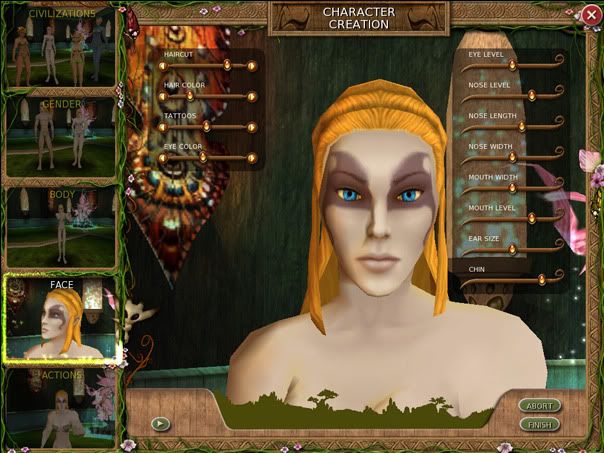 Players may also select from a variety of hairstyles and colors, as well as eye color and tattoos. There are additional hairstyles and tattoos that can be purchased from stylists on the mainland for varying costs. If you would like to view all the options before deciding on a character, you may do so via the dressing room at BallisticMystix.net. You may also view the various armor types, qualities, and colors here; note that there is no restriction to equipping another civilization's armors or weapons. Also note that the only elements of your character's appearance that can be changed after creation are hairstyle and color, as well as tattoos. You may not reshape your character.
Players may also select from a variety of hairstyles and colors, as well as eye color and tattoos. There are additional hairstyles and tattoos that can be purchased from stylists on the mainland for varying costs. If you would like to view all the options before deciding on a character, you may do so via the dressing room at BallisticMystix.net. You may also view the various armor types, qualities, and colors here; note that there is no restriction to equipping another civilization's armors or weapons. Also note that the only elements of your character's appearance that can be changed after creation are hairstyle and color, as well as tattoos. You may not reshape your character.
Before completing creation, players must select an action specialization. Here you may choose additional focus in fighting, magic, foraging, or crafting. The abilities granted by these specializations can still be trained individually, but not every player will want to train those specific abilities at all, so consider this when selecting your actions.
 Once you've finished customizing your Homin, click the 'Finish' button in the lower-right. You will be prompted to select your server (there are three, each representing a language/region - Arispotle is the English server) as well as your default movement keys (these can be changed once in-game), and finally your name, which must be one word and can contain no special characters.
Once you've finished customizing your Homin, click the 'Finish' button in the lower-right. You will be prompted to select your server (there are three, each representing a language/region - Arispotle is the English server) as well as your default movement keys (these can be changed once in-game), and finally your name, which must be one word and can contain no special characters.
Having done all of this, you are ready to begin your own adventures in Atys!
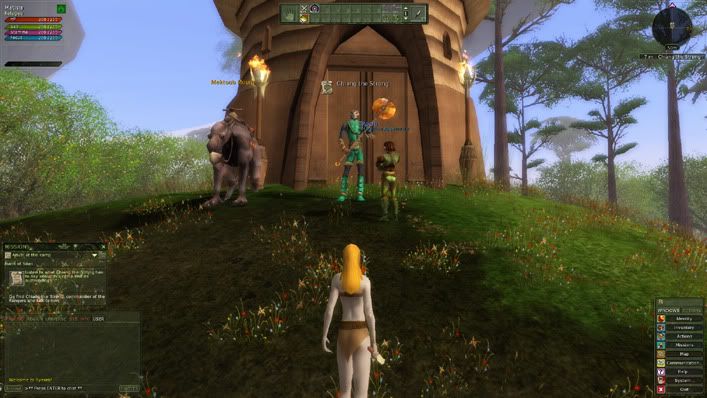 For a larger image, click here.
For a larger image, click here.
The interface windows are as marked:
A] Character Status - Here you can see your name, current title, as well as your pools. The red pool is your health, the green pool is the sap used to cast spells, purple is the action used to perform combat actions, and blue is the focus used to prospect, forage, and craft. In the upper-right corner is the PvP flagging button.
B] Target Status - When you've selected a target, their name, health, and difficulty will be displayed here. More on this in section 5d.
C] Mission Log - You can track the status of your missions through this window. The objectives are displayed at the bottom in white, and will grey out as you complete them in the case of multiple-objective missions.
D] Chat Window - This is your means of communicating with other players. By default there are 5 tabs here: Around (vicinity chat), Region (each ecosystem is divided into a number of regions, which are seamless from one another), Universe (a game-wide channel that is meant to be used only for requesting help / asking questions), Sys. Info (your combat log, etc.), and User (pretty much every tab's incoming messages put together, save for Sys. Info). Joining a team will also cause the team chat tab to appear.
E] Main Menu - Here you can access a variety of additional windows including your personal stats, inventory, friends list, and more.
F] Radar - This allows you to see creatures, players, and resource nodes as blips. When on a mission in the starting areas, a pink arrow at the edge of the radar will guide you to your objective, and the distance will be displayed in meters below. You may also right click the radar and choose from waypoints you have created, and the guide arrow will lead you there.
G] Action Bar - Here you can access your skills and perform actions. You can also right click an empty hotkey (or an existing action) to edit/create a skill of your own. More on this in section 5e.
G1] Main Hand - Clicking on this will allow you to set your main hand weapon or tool.
G2] Off Hand - Clicking on this will allow you to set an off hand weapon or shield.
Now that we've explored the basics of the interface, let's take a look at some of the additional tools available.
First we have the system menu, accessed from the main menu:
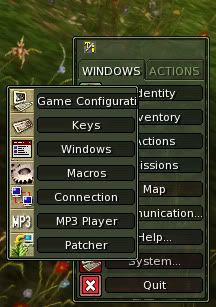
From here you can go into your game configuration and touch up some additional graphical or interface settings, set your keybindings, open additional windows, or more. You'll also see there is an MP3 player option. While Ryzom does not feature any looping music, you may choose to load up tracks for your own listening pleasure. Note that if you are running in full screen, it will be necessary to alt+tab out to the file selection window after choosing to open tracks.
Opening the key bindings window will show a number of additional options that the game does not normally present. The first, and perhaps most important, is the ability to toggle between dodging or parrying attacks via Shift+D by default. In addition, make note of your sit key, as sitting will help to speed up your regeneration. You will also find that you can raise and lower your camera's default position by holding CTRL and pressing either 9 (to raise) or 3 (to lower) on the numpad. This is particularly useful when taking screenshots. One more keybinding to note is the "Front Selection Enemies" key under Actions. This is similar to tab-targeting in other games, and is bound to the space key by default. You may wish to change this for comfort, as hitting tab out of reflex will start cycling through your previous tells if left default!
The other important menu item is the communications button.

From here you can open your contact list, containing friends and ignored players. You will not be able to add players to either list unless they are currently online. You can also check your current fame (or faction/reputation) with varying inhabitants of Atys, check your in-game mail, or visit web resources for the game. While the web button won't open a traditional browser, it will allow you access to forums, news, and profiles relating to the game. Finally you will be able to access your animals, which will include your mounts and pack animals.
The last element of the interface is certainly not the least. The map will allow you to see your position in the world, various respawn points, as well as any markers you have placed. The map itself is not highly detailed, as players are expected to learn the lay of the land for themselves. It will however provide reference points for navigation, and allow you to add markers for resource nodes, teleportation shrines, and other odds and ends. In order to place a marker, right click the map and then choose to place either where your cursor currently is on the map, or in your current location. You can then name the marker, as well as set a category to help keep things organized. The time of day, month, year, season, and weather are all displayed at the top of the map.
While there are additional features to the interface, they are relatively straightforward, and should not require additional explanation.
[5a] The Basics
There are a couple of basics that new players should know before beginning to play Ryzom: the meaning behind the stats, the way weapons function, how to heal up, and the consequences of death.
Constitution determines your maximum HP (or hit/health points). There are many dangers in Atys, and a high constitution is needed to survive them. Not only will wildlife pose a threat, but harvesting resources can result in dire consequences for those who are not gentle with their harvest. It is also used to determine the quality level of armor a player can wear. Higher quality armors will require a higher constitution score. Similarly, heavier armors will require more constitution than lighter armors of the same quality level.
Metabolism determines the regeneration rate of your HP. Constitution and metabolism, being useful to nearly all skill trees, can be trained at any of the skill trainers.
[Juanyi's Helpful Hints: Because skills in crafting, harvesting, and magic are proportionally more expensive than those in fighting, many players choose to use their fighting skill points on HP upgrades, and save their other points for their respective skills]
Intelligence is a magic-user's lifeblood, as it dictates the maximum amount of sap (or mana, for those more familiar with the term) a player has. Sap is used to channel the magic of Atys, and more powerful spells require more sap to be cast. Intelligence also determines the quality of magic amplifiers that can be worn.
Wisdom determines the regeneration rate of your sap. Both intelligence and wisdom can only be trained at a magic trainer.
Strength is to fighters as intelligence is to casters, as every special attack performed will drain a player of his or her stamina, which strength increases. Strength is also needed to equip better quality weapons.
Balance determines the regeneration rate of your stamina. Both strength and stamina can only be trained at a fighter trainer.
Dexterity fuels the focus pool, which crafters use to construct their goods and foragers require to prospect and harvest.
Will determines the regeneration rate of your focus. Both dexterity and will can be trained at either a crafting or foraging trainer.
After dying, a window containing the game map and a respawn button will appear. If you've visited additional shrines in your travels you will have the option to select the shrine you would like to revive at; these look like glowing blue circles. You have about five minutes to be revived before you will automatically be forced to respawn.
The death penalty in Ryzom comes in the form of an experience debt. After dying, you will need to pay off your debt by gaining any type of experience through normal means. The higher your overall skill totals, the more experience must be paid. On average this can be cleared up in a few kills of even-level creatures. [Jianyu's Helpful Hints: Due to the value of crafting materials, its best to avoid crafting if you have any outstanding experience debt.]
[5b] The Ruins of Silan
New characters will begin as refugees on an island called the Ruins of Silan. Without pageantry of any kind, you are dropped into the Rangers' Camp with little more than starting weapons and the clothes on your back. In front of you will be Chiang the Strong, whom you will need to talk to in order to continue your starting mission. Due to the nature of the game, even seasoned MMO veterans will want to read every possible dialogue and pop-up. Not only will this introduce you to the world, but it will also teach you important basics about the game.
Shortly after meeting with Chiang, you'll be sent to meet with one of the four racial leaders; one for each skill tree. They will each offer a series of missions that award substantial experience and good starting equipment. If you intend to train in all four skills, I advise completing each mission from each trainer alongside the others, as they will often intersect and require you to go to the same region or defeat the same enemies. If you would like to see a full guide for these missions, there is an excellent write-up on the Ryzom forums. Note that some missions will require teamwork, in which case you'd be best suited to ask for assistance in the Universe channel. Some players keep well-geared and high-skilled alts on Silan specifically to help new players.
It is possible to train your skills to upwards of 60 in Silan, although you may leave the island at any time you wish. There is no requirement to train or complete any quests, but the mainland is a more challenging place and new players will benefit from the lessons on the starting island. In order to travel to the mainland, speak with Chiang the Strong. Note that you must not be on the initial mission given upon logging in for the first time in order to accept his quest to leave the island. Also note that you cannot return to Silan after leaving.
[5c] The Four Skill Trees
There are four primary skills in Ryzom: fighting, magic, crafting, and foraging. Players are not restricted from training in any amount of these, although as more skill levels are gained, the trees branch out to become more and more specific. Mastering every skill would be quite a feat, but most players will still choose to dabble in all four fields to some extent. In order to gain experience in a specific skill, you will need to use the relevant ability. As an example, offensive magic experience is gained by casting offensive magic spells, while defensive magic experience is gained by healing or casting defensive spells.
Each time you gain a skill level, you will be awarded 10 points for use at that skill's trainer. These points can then be used to purchase new abilities, stanzas, or upgrades to your statistics. Be aware that some skills have prerequisites in order to be learned; you can view these in-game by opening your action window ('B' key by default) and clicking on the skill tree in question. The abilities trainable from that tree will be located in a panel to the right, and you can right-click those to view their prerequisites.
Fighters in Atys will want to equip themselves with medium or heavy armors. Medium armors are more suited for offensive roles, due to the cost penalties inflicted by heavy armor.
A principal lesson of magic is that not all creatures on Atys share the same weaknesses. The acid spell which is given to new players is highly effective against normal wildlife, but plant life and the Kitin are not greatly affected by it. Players will need to discover the rot spell to fight the living plants, and the cold spell to combat the Kitin menace. Additional elements will open up further into the magician's training as well.
In order to most effectively use spells, players will need to equip their magic amplifiers. Amplifiers will often have varying properties that increase the damage and casting speeds of affliction, elemental, and beneficial magics. It is important to inspect amplifiers to see which will suit your purposes best.
Ryzom also differentiates itself from other games by how its affliction spells function. Damage over time effects, crowd control spells, and similar abilities are meant moreso for group play than for soloing, as these spells must be maintained by the caster through channeling. Movement or other action will cancel these spells, but a focused magician will be able to turn the tide of battle for his team.
Crafted items are, of course, reliant upon the materials that are used in their creation. Materials in Ryzom come in a variety of qualities, colors, and with differing statistics. Understanding how these are calculated to determine the final product is part of the path to becoming a truly great artisan. Materials can be acquired either by quartering them from creatures, foraging for them from resources nodes, or purchasing them from other players.
Using the prospecting skill players can journey out into the wild, track down an area rich in resources, and bring the nodes up from beneath the ground to be harvested. Because they are initially hidden, it takes a degree of patience and learning to become a skilled prospector. As you grow in foraging, you will be able to purchase skills such as deposit tracking, which will help you to locate nearby resource deposits. Once activating this tracking ability, green text at the bottom of your screen will inform you of the distance to the nearest deposit. You must then follow the continuing hints given by these messages to locate the nodes, at which point you may begin prospecting.
Don't be discouraged if you find yourself having difficulty locating the precise location of a node. As you train, you will eventually be able to increase the range and radius of your prospecting. In addition, you can learn to track or prospect only for a certain quality or type of material. Prospected nodes have the benefit of returning the focus used to forage to the player upon completion of their harvest, as well as awarding additional experience when compared to exposed nodes.
When harvesting it is important to keep an eye on the status of your node.
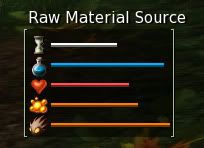
The first meter represents the time remaining on the node. When this meter is exhausted, the node will disappear, and you will need to prospect for another. The second meter shows the quantity of resources still remaining in the node. At earlier levels you will only be able to prospect for one or two materials per node, but increased training will allow you to extract higher qualities faster.
The third meter represents the life of the node. There are two forms of extracting materials - harmful and gentle. Harmful extraction is trained earlier, but risks exhausting the life of the node more quickly. It is possible for the node's life to deplete before the timer runs out. Harmful extraction also risks depleting the fourth meter, which represents the node's stability. If this meter reaches zero, the node will explode in either an immediate area-effect damage, or will release toxic gases that will reduce your health for as long as you stand in them. While this may add a sense of urgency to your harvest, it will not exhaust the node itself.
The final bar represents the Kami tolerance for foraging in a given region. As protectors of the balance of Atys, the Kami do not look kindly upon the wanton extraction of natural resources. Should this meter reach zero...well, you have been warned.
Foraging can become a group activity, as players are able to learn skills that will allow them to prevent the depletion of these varying meters while another player harvests, thereby increasing the potential quality and quantity of the extracted resources. Keep in mind however that continuous harvesting of a single resource will eventually deplete that resource, and you will need to give the planet some time to heal before you can harvest from that location again.
[5d] Enemy 'Conning' System
Crucial to a life of adventure is the ability to understand the relative difficulty of the dangerous creatures around you. In order to do this, you must look at your target window after selecting a creature.

There are some obvious things to point out here. You have the name of the creature, the health bar, but what exactly do those numbers mean? Well, the number in the circle represents the level of the creature. A level 8 suckling capryni might make a good hunt for a level 3 fighter, but not so much for one at level 25. Generally the number of stars above its creatures head are meaningless, as is the color of the circle the level number is in - these are only general representations of level that help to identify creatures who are too high for you to see their specific levels.
Some creatures in Atys are identified specifically as team level challenges. By mousing over the circle containing the creature's level, it will inform you if this is the case.
There is no method by which to tell if a creature is aggressive or social, save for doing so by old fashioned trial and error. Embrace the bountiful life on Atys, and learn for yourself just what kinds of odd creatures inhabit it!
[5e] Building Actions
Ryzom's most unique feature by far is the ability to build and customize your own actions, be they crafting, harvesting, or combat related. This is done through the game's stanza system, which is a balancing act of skill elements with costs. To understand how this works, we must first look at the interface for creating a skill. To do this, either right click an existing skill and choose to edit it, or right click an empty hotbutton to create a new action.
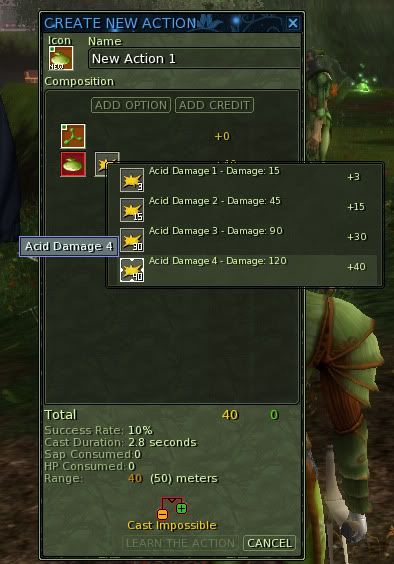
Here you can see I am beginning to create an acid spell. I've done this by first selecting the offensive missile spell blueprint, and then by clicking the "add option" button, adding elemental acid damage. I can now select the degree of damage I wish to apply. I've decided to go for my highest trained damage with Acid 4. Because of this, I now have an action cost of 40 that I must make up for by adding credits before I can learn the action.
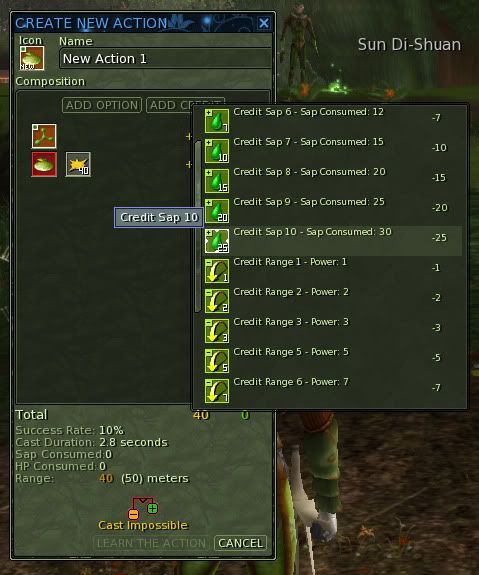
Here is a list of some credits I have available to me. For the most part they consist of additional casting time, range, or sap, although I could also learn to add, for example, a health cost. The more a credit impacts my spell, the more value I will get for applying it. In order to make up the 40 points needed, I will add the Sap 10 credit worth 25, the Range 5 credit worth 5, as well as a casting time credit higher in the list of options that will cover the last 10. The final skill formula will look like this:
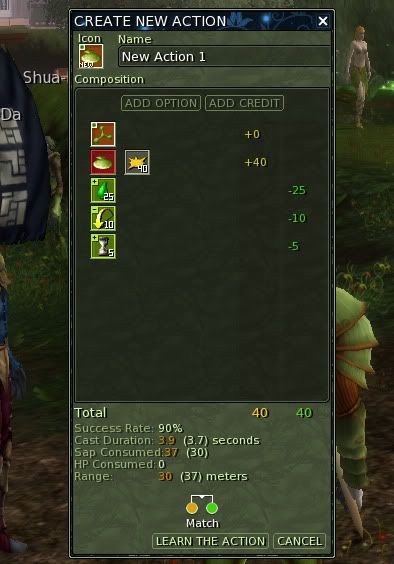
I can now see the details of my action such as the success rate, cast duration, sap consumption, and range, and I am able to confirm the action, though I may wish to name it before doing so. The stanza system can be used to create a variety of abilities, such as specifying a type of material in a prospecting action or adding an area effect property to a spell. With increased training you will learn additional options and credits, and these can be combined to create new formulas that may not have been available otherwise, for example you may choose to edit a lower damage spell with a higher sap cost, in exchange for increased range or reduced casting time. Your character's abilities are ultimately in your own hands!
That is not to say that Ryzom has no traditional quests or missions after Silan. There are in fact a variety of tasks that can be completed for the inhabitants of Atys, but these are mostly to generate currency, or in the case of rites, to earn cubes of amber that will teach you about the lore of the world. Do not expect to be led through a quest progression that will support your leveling needs.
The reward of the game is not in reaching the highest skill levels, but in immersing yourself in the experience Atys offers. Take in the sights and sounds, observe the creature behaviors, and learn to be a part of a virtual world rather than just another toon on a leveling treadmill. Take risks and explore, and you will find the rewards are greater than any shiny boss loots.
Getting Started in


Table of Contents
[1] What is Ryzom?
[1a] Why This Game is Unique
[1b] Who is Ryzom's Target Audience?
[1c] Atys, the Living Planet
[1d] The Four Civilizations
[1e] The Kami and The Karavan
[2] Getting Started
[2a] Downloading the Game
[2b] Creating an Account
[2c] Configuration
[3] Character Creation
[4] The Interface
[5] How to Play
[5a] The Basics
[5b] The Ruins of Silan
[5c] The Four Skill Trees
[5d] Enemy 'Conning' System
[5e] Building Actions
[6] The Mainland
[7] Tips & Tricks
[8] Useful Links
[1] What is Ryzom?
Ryzom is a massively multiplayer online role-playing game (MMORPG). Developed by french studio Nevrax, the game launched in mid-September 2004 as "The Saga of Ryzom", the game boasted a sandbox environment influenced by its players. For a variety of reasons (notably a confusing initial design, a patch that many players disliked, poor release of the Ryzom Ring, and the successive releases of EverQuest 2 and World of Warcraft) the game did not acquire a strong following. After Nevrax entered into receivership, the game changed hands until finally being shut down in October 2007.In August 2008, new owners of the game returned the servers to life. Since that time the game has seen small developments and improvements, as well as some new external features. The game continues to survive, nurtured by the passion of its players and development team.
[1a] Why This Game is Unique
Ryzom is unique in the MMORPG market for a number of reasons. The most apparent to anyone looking at the game will be the setting; rather than a traditional fantasy or science fiction, Ryzom introduces races, creatures, and environments that are completely alien. This is both daunting and liberating, as players are expected to forget the comforts of the stories they are familiar with and embrace completely new concepts.
The game features an open-ended character development system. Player progression is not determined by a predefined class or profession, but rather by the choices the player makes in developing their skill trees. Players may choose to specialize in fighting, magic, crafting, or foraging; but to experience the game to its fullest, most will explore all four. These initial specializations divide further as a player gains skill levels, for example fighting will divide into melee and ranged fighting; melee fighting will divide into one-handed, two-handed, and close-combat specializations, and those specializations will split further into their respective weapons. There is no limit to how many skills a player can master, although mastering them all would surely be a challenge.
In addition to the skill trees, players are able to design their own skills and spells through the use of stanzas. By combining attack properties such as damage type or area of effect with costs and limits, players can effectively customize their skills to suit their play style. This is explained further in section 5e.
The game also sets itself apart through the design of its world. Atys is a planet in constant change; not only does the game cycle through the seasons, but creatures will migrate, resources will shift, and outposts will change hands. Daily life will change for players as well as the game hinges on interdependency. With the economy and the story in constant flux, a life on Atys is an ever-evolving one.
[1b] Who is Ryzom's Target Audience?
While the game may appeal to a variety of players, there is little question that in this day, Ryzom is targeted at roleplayers seeking an immersing sandbox experience. With its complex world design and free-form gameplay, as well as the ability for players to create and 'DM' their own instanced scenarios (not covered in this guide), the game should appeal to anyone looking for a deep and engaging MMORPG where imagination takes precedence over progression and status.
Ryzom also sees heavy roleplaying support from its owners, allowing players to embed themselves in the ongoing storyline of the game.
While I would not discourage anyone from trying the game, consider it fair warning that players interested in traditional treadmill games with pre-written storylines and large amounts of solo play will not find it here. An open mind and desire to experience something new will be the key to finding your enjoyment in Ryzom.
[1c] Atys, the Living Planet

In the far reaches of space in an unknown galaxy, a lush green planet teems with life. This planet is not like those we know; it is not formed of rocks, minerals, and ore. Instead, the planet is a singular organic entity - a gargantuan tree, growing ever-outward. On the bark of this tree live the Homins, the people of Atys not unlike humans. In the skies above are the canopies; gargantuan branches extending far into the horizon. Below are the Prime Roots, the cavernous dark filled with the planet's riches. Homins must not explore too deep, lest they breach the core and incite the ferocious Kitins within.
The playable area of Atys is divided into five distinct geographical regions. On the planet's bark are the forests, the desert, the lake-lands, and the jungles. Each region is home to a native Homin civilization. Also open for exploration are the Prime Roots, where Atys's greatest challenges and treasures await.
[1d] The Four Civilizations
Players of Ryzom may choose to create a character in any of the four civilizations: Fyros, Matis, Tryker, or Zoraï. Each civilization has its own distinct culture reflected not only in their cities, but also the armor and weapons they create.
View a trailer introducing the four civilizations.

Fyros, Masters of Fire
Determined, loyal, and fierce, the Fyros have built their kingdom in the harsh deserts and consider themselves to be the protectors of the fertile regions of Atys. Their society rests on a strict code of honor and the common goal of finding and eradicating the dreaded Great Dragon of legend.
Apart from striving for social dominance and the restoration of their Empire, the Fyros have taken it upon themselves to protect the environment from the ravages of fire. These masters of flame also aspire to further develop their already extensive knowledge of the fabrication of fire-toughened tools and weaponry.

Matis, Lords of the Bark
Beautiful and powerful, the Matis are both a romantic and conquering race. The Matis seek to rebuild their majestic kingdom, a legend of the ancient lands, but their own intrigues consume all their energy as each family vies for the crown. As proud heirs of an ancient monarchy, they staunchly believe that just as every particle of the universe has a function, every homin must strive for his or her true place in society - even if it means conquering other civilizations to attain it.
Well versed in botany, as well as genetic manipulation, the Matis have taken root in the forested areas of the new lands, where they are able to find every living essence needed for their experimentation. The Matisian villages are sculpted into majestic trees and their strange and wonderful gardens are a marvel to behold.

Tryker, Children of the Wind
Shorter of statue than the other homin races, the Tryker have retained their flighty and carefree nature despite the events of the past. Excellent explorers and inventors, as well as experts in wind technology, the Tryker have built their new civilization in marvelous floating cities of the lakelands, dreaming of a world without the burdens of tyranny or intolerance.
In their penchant for conservationism, the Tryker have also developed the technique of water purification, and they continue to look on water not only for its biological value but seek to use it for energetic ends.

Zoraï, Keepers of the Wild
Often feared by other civilizations, the Zoraï are mystics from the dark jungles who zealously serve the living planet and quest to cleanse the Goo. In their search for spiritual enlightenment, the Zoraï have grown close to the mysterious Kami, whom they regard as higher disciples of Ma-Duk. They proudly wear the Kami mask of kinship, which is genetically bonded to their faces, distinguishing them from other homins.
Masters in the manipulation of electrical and magnetic fields, the Zoraï take advantage of these forces in the fabrication of their weaponry and buildings. Structured around magnificent temple-cities, the Zoraï not only seek to restore the glory of their former dynasty but are also keen to promote spiritual awareness throughout the newfound lands.
[1e] The Kami and The Karavan

Mysterious and powerful, the Kami and the Karavan are held in awe, if not venerated, by all of the homin civilizations. These beings possess intimate knowledge of the world and are considered the ultimate authorities on the arts of magic and technology - when they choose to share that knowledge.
The Kami are the guardians of plant life and the organic balance of the world and are responsible for teaching homins the art of magic.
The Karavan are masters of unknown technology with devastating powers and spread the holy word of the Goddess Jena.
For many centuries these two forces have kept their distance, observing one another in a cold war, joining together only to push back the Kitin.
Read more about the KaravanRead more about the Kami
[2] Getting Started
[2a] Downloading the GameRyzom can be downloaded by visiting the game's website at Ryzom.com. Players have the option to download Ryzom directly, through a torrent, or through a mirror. After downloading, simply run the installation setup and follow the prompts, and you'll be ready to launch the game!

[2b] Creating an Account
Accounts can be registered at secure.ryzom.com/signup/. No credit card is necessary, and the game is free to try for 21 days. The trial has no artificial restrictions placed on it, and players may experience the full game during their trial period. After registering, players will need to confirm their accounts through the e-mail provided before logging in.
[2c] Configuration
After launching the game, players will be presented with a login screen. From here they may access the Game Configuration settings. Once the configuration page has loaded, you may change your resolution, graphical and sound settings, as well as access debugging options should you find them necessary.
[3] Character Creation
[Jianyu's Helpful Hints: Click the play arrow in the lower-left corner during character creation to animate your future Homin! Each civilization and gender has its own unique animation cycle.]
After logging in (which, by the way, must be done with your username in lowercase), players will be taken to a windowed version of the character select screen. To create a new character, select an empty slot and click on the 'Create New' button in the lower-right corner.

Facial customization is also possible. Although the basic shape of the head cannot be altered (save for the chin), the facial features may be reshaped or repositioned.

Before completing creation, players must select an action specialization. Here you may choose additional focus in fighting, magic, foraging, or crafting. The abilities granted by these specializations can still be trained individually, but not every player will want to train those specific abilities at all, so consider this when selecting your actions.

Having done all of this, you are ready to begin your own adventures in Atys!
[4] The Interface
[Jianyu's Helpful Hints: If using a wide screen monitor, you will need to set your aspect ratio individually from the screen resolution. You can do this by going into system -> game configuration -> graphics -> general. Set the ratio to Auto using the drop-down menu, and it will adjust the image to the appropriate resolution.]
An important element of any MMORPG, Ryzom's interface is relatively simple, but there are some hidden windows and controls that aren't readily noticeable. First, let's take a look at the core interface:

The interface windows are as marked:
A] Character Status - Here you can see your name, current title, as well as your pools. The red pool is your health, the green pool is the sap used to cast spells, purple is the action used to perform combat actions, and blue is the focus used to prospect, forage, and craft. In the upper-right corner is the PvP flagging button.
B] Target Status - When you've selected a target, their name, health, and difficulty will be displayed here. More on this in section 5d.
C] Mission Log - You can track the status of your missions through this window. The objectives are displayed at the bottom in white, and will grey out as you complete them in the case of multiple-objective missions.
D] Chat Window - This is your means of communicating with other players. By default there are 5 tabs here: Around (vicinity chat), Region (each ecosystem is divided into a number of regions, which are seamless from one another), Universe (a game-wide channel that is meant to be used only for requesting help / asking questions), Sys. Info (your combat log, etc.), and User (pretty much every tab's incoming messages put together, save for Sys. Info). Joining a team will also cause the team chat tab to appear.
E] Main Menu - Here you can access a variety of additional windows including your personal stats, inventory, friends list, and more.
F] Radar - This allows you to see creatures, players, and resource nodes as blips. When on a mission in the starting areas, a pink arrow at the edge of the radar will guide you to your objective, and the distance will be displayed in meters below. You may also right click the radar and choose from waypoints you have created, and the guide arrow will lead you there.
G] Action Bar - Here you can access your skills and perform actions. You can also right click an empty hotkey (or an existing action) to edit/create a skill of your own. More on this in section 5e.
G1] Main Hand - Clicking on this will allow you to set your main hand weapon or tool.
G2] Off Hand - Clicking on this will allow you to set an off hand weapon or shield.
Now that we've explored the basics of the interface, let's take a look at some of the additional tools available.
First we have the system menu, accessed from the main menu:

From here you can go into your game configuration and touch up some additional graphical or interface settings, set your keybindings, open additional windows, or more. You'll also see there is an MP3 player option. While Ryzom does not feature any looping music, you may choose to load up tracks for your own listening pleasure. Note that if you are running in full screen, it will be necessary to alt+tab out to the file selection window after choosing to open tracks.
Opening the key bindings window will show a number of additional options that the game does not normally present. The first, and perhaps most important, is the ability to toggle between dodging or parrying attacks via Shift+D by default. In addition, make note of your sit key, as sitting will help to speed up your regeneration. You will also find that you can raise and lower your camera's default position by holding CTRL and pressing either 9 (to raise) or 3 (to lower) on the numpad. This is particularly useful when taking screenshots. One more keybinding to note is the "Front Selection Enemies" key under Actions. This is similar to tab-targeting in other games, and is bound to the space key by default. You may wish to change this for comfort, as hitting tab out of reflex will start cycling through your previous tells if left default!
The other important menu item is the communications button.

From here you can open your contact list, containing friends and ignored players. You will not be able to add players to either list unless they are currently online. You can also check your current fame (or faction/reputation) with varying inhabitants of Atys, check your in-game mail, or visit web resources for the game. While the web button won't open a traditional browser, it will allow you access to forums, news, and profiles relating to the game. Finally you will be able to access your animals, which will include your mounts and pack animals.
The last element of the interface is certainly not the least. The map will allow you to see your position in the world, various respawn points, as well as any markers you have placed. The map itself is not highly detailed, as players are expected to learn the lay of the land for themselves. It will however provide reference points for navigation, and allow you to add markers for resource nodes, teleportation shrines, and other odds and ends. In order to place a marker, right click the map and then choose to place either where your cursor currently is on the map, or in your current location. You can then name the marker, as well as set a category to help keep things organized. The time of day, month, year, season, and weather are all displayed at the top of the map.
While there are additional features to the interface, they are relatively straightforward, and should not require additional explanation.
[5] How to Play
This next section will, to the best of my ability, address how to jump into the game and begin playing. Keep in mind that, aside from a couple of tutorials,most information in this section is subjective. It is only meant to springboard you into discovering the depth of the game for yourself, and avoid as many new player frustrations as possible.[5a] The Basics
There are a couple of basics that new players should know before beginning to play Ryzom: the meaning behind the stats, the way weapons function, how to heal up, and the consequences of death.
Statistics
Players will focus on 8 primary statistics in Ryzom. Each pool has two related statistics, one controlling the maximum of that pool, and the other determining the regeneration rate.Constitution determines your maximum HP (or hit/health points). There are many dangers in Atys, and a high constitution is needed to survive them. Not only will wildlife pose a threat, but harvesting resources can result in dire consequences for those who are not gentle with their harvest. It is also used to determine the quality level of armor a player can wear. Higher quality armors will require a higher constitution score. Similarly, heavier armors will require more constitution than lighter armors of the same quality level.
Metabolism determines the regeneration rate of your HP. Constitution and metabolism, being useful to nearly all skill trees, can be trained at any of the skill trainers.
[Juanyi's Helpful Hints: Because skills in crafting, harvesting, and magic are proportionally more expensive than those in fighting, many players choose to use their fighting skill points on HP upgrades, and save their other points for their respective skills]
Intelligence is a magic-user's lifeblood, as it dictates the maximum amount of sap (or mana, for those more familiar with the term) a player has. Sap is used to channel the magic of Atys, and more powerful spells require more sap to be cast. Intelligence also determines the quality of magic amplifiers that can be worn.
Wisdom determines the regeneration rate of your sap. Both intelligence and wisdom can only be trained at a magic trainer.
Strength is to fighters as intelligence is to casters, as every special attack performed will drain a player of his or her stamina, which strength increases. Strength is also needed to equip better quality weapons.
Balance determines the regeneration rate of your stamina. Both strength and stamina can only be trained at a fighter trainer.
Dexterity fuels the focus pool, which crafters use to construct their goods and foragers require to prospect and harvest.
Will determines the regeneration rate of your focus. Both dexterity and will can be trained at either a crafting or foraging trainer.
Weaponry
Ryzom places a degree of importance on upgrading your weaponry that is not normally encountered in games. While you are able to perform any attack or cast any spell that you please, you will only receive the benefits from your equipped weapon if it is of a high enough quality in relation to the action's level. As an example, you will not receive casting speed or damage bonuses when casting Acid Damage 2 with quality 10 amplifiers, but quality 15 amplifiers will work just fine. If a weapon is too low to augment a skill, you will receive notice each time you use that skill.Healing
The healing system in the game is a little unorthodox. In traditional games players can supplement their regeneration rates with food or healing spells. While the game does have healing spells available, these can only be used to heal other players. Instead players need to train in special "Self Heal" abilities. These exist for each of the four pools, and share the same 3 minute cooldown. Each level of training in these self heals increases the amount healed by 100. Of course if you're stingy with your skill points, you can always sit down and regenerate the old fashioned way.Death
As with most games, a character dies when his health reaches 0. Should you die in Ryzom, you have two options. The first is to await a resurrection - this can be done by any player with a healing spell. Rather than a traditional resurrection spell, a player only needs to heal you back to consciousness. The other is to choose to respawn at a resurrection shrine. After dying, a window containing the game map and a respawn button will appear. If you've visited additional shrines in your travels you will have the option to select the shrine you would like to revive at; these look like glowing blue circles. You have about five minutes to be revived before you will automatically be forced to respawn.
The death penalty in Ryzom comes in the form of an experience debt. After dying, you will need to pay off your debt by gaining any type of experience through normal means. The higher your overall skill totals, the more experience must be paid. On average this can be cleared up in a few kills of even-level creatures. [Jianyu's Helpful Hints: Due to the value of crafting materials, its best to avoid crafting if you have any outstanding experience debt.]
[5b] The Ruins of Silan
New characters will begin as refugees on an island called the Ruins of Silan. Without pageantry of any kind, you are dropped into the Rangers' Camp with little more than starting weapons and the clothes on your back. In front of you will be Chiang the Strong, whom you will need to talk to in order to continue your starting mission. Due to the nature of the game, even seasoned MMO veterans will want to read every possible dialogue and pop-up. Not only will this introduce you to the world, but it will also teach you important basics about the game.
Shortly after meeting with Chiang, you'll be sent to meet with one of the four racial leaders; one for each skill tree. They will each offer a series of missions that award substantial experience and good starting equipment. If you intend to train in all four skills, I advise completing each mission from each trainer alongside the others, as they will often intersect and require you to go to the same region or defeat the same enemies. If you would like to see a full guide for these missions, there is an excellent write-up on the Ryzom forums. Note that some missions will require teamwork, in which case you'd be best suited to ask for assistance in the Universe channel. Some players keep well-geared and high-skilled alts on Silan specifically to help new players.
It is possible to train your skills to upwards of 60 in Silan, although you may leave the island at any time you wish. There is no requirement to train or complete any quests, but the mainland is a more challenging place and new players will benefit from the lessons on the starting island. In order to travel to the mainland, speak with Chiang the Strong. Note that you must not be on the initial mission given upon logging in for the first time in order to accept his quest to leave the island. Also note that you cannot return to Silan after leaving.
[5c] The Four Skill Trees
There are four primary skills in Ryzom: fighting, magic, crafting, and foraging. Players are not restricted from training in any amount of these, although as more skill levels are gained, the trees branch out to become more and more specific. Mastering every skill would be quite a feat, but most players will still choose to dabble in all four fields to some extent. In order to gain experience in a specific skill, you will need to use the relevant ability. As an example, offensive magic experience is gained by casting offensive magic spells, while defensive magic experience is gained by healing or casting defensive spells.
Each time you gain a skill level, you will be awarded 10 points for use at that skill's trainer. These points can then be used to purchase new abilities, stanzas, or upgrades to your statistics. Be aware that some skills have prerequisites in order to be learned; you can view these in-game by opening your action window ('B' key by default) and clicking on the skill tree in question. The abilities trainable from that tree will be located in a panel to the right, and you can right-click those to view their prerequisites.
Fighting
The standard form of combat in Ryzom, the fighting tree encompasses both melee and ranged weaponry. Basic attacks consist of bonuses to damage or accuracy, although these can be combined into a single attack for a higher cost. As your training continues, you will be able to select from a variety of additional stanzas that will allow you to add special creature damage bonuses to attacks, create conditional attacks based on parries/dodges, add area damage, and other improvements. Fighting trainers can also teach players taunt and defensive skills.Fighters in Atys will want to equip themselves with medium or heavy armors. Medium armors are more suited for offensive roles, due to the cost penalties inflicted by heavy armor.
Magic
Delivered to Hominkind by the mysterious Kami, the magic tree allows a player dominion over a wide variety of skills. Whether it is to harness destructive elements or heal their allies, a player who follows the path of magic will find himself discovering new and more powerful ways to tackle the challenges of Atys. Much like fighting, magic users will discover that as their training continues, they are able to create more varied spells, adding elements such as cone, chain, or area effect properties, among other things.A principal lesson of magic is that not all creatures on Atys share the same weaknesses. The acid spell which is given to new players is highly effective against normal wildlife, but plant life and the Kitin are not greatly affected by it. Players will need to discover the rot spell to fight the living plants, and the cold spell to combat the Kitin menace. Additional elements will open up further into the magician's training as well.
In order to most effectively use spells, players will need to equip their magic amplifiers. Amplifiers will often have varying properties that increase the damage and casting speeds of affliction, elemental, and beneficial magics. It is important to inspect amplifiers to see which will suit your purposes best.
Ryzom also differentiates itself from other games by how its affliction spells function. Damage over time effects, crowd control spells, and similar abilities are meant moreso for group play than for soloing, as these spells must be maintained by the caster through channeling. Movement or other action will cancel these spells, but a focused magician will be able to turn the tide of battle for his team.
Crafting
Crafting is the core of Ryzom's economy. Every weapon or piece of armor or jewelry that holds any meaningful value is the product of the hard-working crafters of Atys. Starting out, players will have a melee armor crafting tool and one or two recipes depending on their chosen specialization at creation. With these simple patterns, basic armor pieces can be created and provide the skill points necessary to branch out into additional types of crafting (which require additional crafting tools), as well as to acquire stanzas that will, for example, allow a crafter to create an item with a bonus to one of the four pools. While initially crafters will only be offered the patterns for their civilization's styles, it is possible to make the journey into the other regions to learn patterns not native to their people.Crafted items are, of course, reliant upon the materials that are used in their creation. Materials in Ryzom come in a variety of qualities, colors, and with differing statistics. Understanding how these are calculated to determine the final product is part of the path to becoming a truly great artisan. Materials can be acquired either by quartering them from creatures, foraging for them from resources nodes, or purchasing them from other players.
Foraging
Homins whose heart belongs in the wild will find themselves at home with foraging. There are two primary methods to foraging in Atys. The first is to do so from exposed nodes near the beginning outpost on the starting island, and the primary cities on the mainland. These materials are crude and while make for good experience gain at lower levels, are nowhere near comparable to the materials that can be found via the second method of harvesting: prospecting.Using the prospecting skill players can journey out into the wild, track down an area rich in resources, and bring the nodes up from beneath the ground to be harvested. Because they are initially hidden, it takes a degree of patience and learning to become a skilled prospector. As you grow in foraging, you will be able to purchase skills such as deposit tracking, which will help you to locate nearby resource deposits. Once activating this tracking ability, green text at the bottom of your screen will inform you of the distance to the nearest deposit. You must then follow the continuing hints given by these messages to locate the nodes, at which point you may begin prospecting.
Don't be discouraged if you find yourself having difficulty locating the precise location of a node. As you train, you will eventually be able to increase the range and radius of your prospecting. In addition, you can learn to track or prospect only for a certain quality or type of material. Prospected nodes have the benefit of returning the focus used to forage to the player upon completion of their harvest, as well as awarding additional experience when compared to exposed nodes.
When harvesting it is important to keep an eye on the status of your node.

The first meter represents the time remaining on the node. When this meter is exhausted, the node will disappear, and you will need to prospect for another. The second meter shows the quantity of resources still remaining in the node. At earlier levels you will only be able to prospect for one or two materials per node, but increased training will allow you to extract higher qualities faster.
The third meter represents the life of the node. There are two forms of extracting materials - harmful and gentle. Harmful extraction is trained earlier, but risks exhausting the life of the node more quickly. It is possible for the node's life to deplete before the timer runs out. Harmful extraction also risks depleting the fourth meter, which represents the node's stability. If this meter reaches zero, the node will explode in either an immediate area-effect damage, or will release toxic gases that will reduce your health for as long as you stand in them. While this may add a sense of urgency to your harvest, it will not exhaust the node itself.
The final bar represents the Kami tolerance for foraging in a given region. As protectors of the balance of Atys, the Kami do not look kindly upon the wanton extraction of natural resources. Should this meter reach zero...well, you have been warned.
Foraging can become a group activity, as players are able to learn skills that will allow them to prevent the depletion of these varying meters while another player harvests, thereby increasing the potential quality and quantity of the extracted resources. Keep in mind however that continuous harvesting of a single resource will eventually deplete that resource, and you will need to give the planet some time to heal before you can harvest from that location again.
[5d] Enemy 'Conning' System
Crucial to a life of adventure is the ability to understand the relative difficulty of the dangerous creatures around you. In order to do this, you must look at your target window after selecting a creature.

There are some obvious things to point out here. You have the name of the creature, the health bar, but what exactly do those numbers mean? Well, the number in the circle represents the level of the creature. A level 8 suckling capryni might make a good hunt for a level 3 fighter, but not so much for one at level 25. Generally the number of stars above its creatures head are meaningless, as is the color of the circle the level number is in - these are only general representations of level that help to identify creatures who are too high for you to see their specific levels.
Some creatures in Atys are identified specifically as team level challenges. By mousing over the circle containing the creature's level, it will inform you if this is the case.
There is no method by which to tell if a creature is aggressive or social, save for doing so by old fashioned trial and error. Embrace the bountiful life on Atys, and learn for yourself just what kinds of odd creatures inhabit it!
[5e] Building Actions
Ryzom's most unique feature by far is the ability to build and customize your own actions, be they crafting, harvesting, or combat related. This is done through the game's stanza system, which is a balancing act of skill elements with costs. To understand how this works, we must first look at the interface for creating a skill. To do this, either right click an existing skill and choose to edit it, or right click an empty hotbutton to create a new action.

Here you can see I am beginning to create an acid spell. I've done this by first selecting the offensive missile spell blueprint, and then by clicking the "add option" button, adding elemental acid damage. I can now select the degree of damage I wish to apply. I've decided to go for my highest trained damage with Acid 4. Because of this, I now have an action cost of 40 that I must make up for by adding credits before I can learn the action.

Here is a list of some credits I have available to me. For the most part they consist of additional casting time, range, or sap, although I could also learn to add, for example, a health cost. The more a credit impacts my spell, the more value I will get for applying it. In order to make up the 40 points needed, I will add the Sap 10 credit worth 25, the Range 5 credit worth 5, as well as a casting time credit higher in the list of options that will cover the last 10. The final skill formula will look like this:

I can now see the details of my action such as the success rate, cast duration, sap consumption, and range, and I am able to confirm the action, though I may wish to name it before doing so. The stanza system can be used to create a variety of abilities, such as specifying a type of material in a prospecting action or adding an area effect property to a spell. With increased training you will learn additional options and credits, and these can be combined to create new formulas that may not have been available otherwise, for example you may choose to edit a lower damage spell with a higher sap cost, in exchange for increased range or reduced casting time. Your character's abilities are ultimately in your own hands!
[6] The Mainland
Having reached a comfortable level of training in the ruins of Silan, you've decided to take the plunge and journey onwards to the mainland. Now your life as a Homin truly begins. The mainland offers a diverse array of challenges that you as a player will need to grow and learn to face. The missions available to you now will no longer supplement your experience gains or reward you with improved equipment; you will need to meet other Homins and learn to hunt for your living.That is not to say that Ryzom has no traditional quests or missions after Silan. There are in fact a variety of tasks that can be completed for the inhabitants of Atys, but these are mostly to generate currency, or in the case of rites, to earn cubes of amber that will teach you about the lore of the world. Do not expect to be led through a quest progression that will support your leveling needs.
The reward of the game is not in reaching the highest skill levels, but in immersing yourself in the experience Atys offers. Take in the sights and sounds, observe the creature behaviors, and learn to be a part of a virtual world rather than just another toon on a leveling treadmill. Take risks and explore, and you will find the rewards are greater than any shiny boss loots.
[7] Tips and Tricks
- Always be aware of your surroundings. Not only is it important to watch for aggressive predators, but you will find that simple features in the geography become invaluable guides when navigating Atys.
- Make liberal use of map markers. Once you've stumbled upon a resource node, jot it down! You may find yourself looking for those exact resources for your crafting later on.
- Want to zoom your camera out further? Go into your Ryzom folder, open the client.cfg file through notepad (or word processing program of your choice), and add this line:
- CameraDistMax = 50.0000000000;
- When placing an item up for sale to players through an NPC, make note of the mark-up percentage. You're free to set this as high as you see fit, and you don't even have to collect the money if it sells - it will be deposited right into your inventory.
- If space is running low, consider investing in a Mektoub Packer. These beasts of burden will hold large quantities for you, and make for excellent traveling companions, but be wary of predators looking to make a snack out of your four-legged friend.
- If you need help with something, ask! Ryzom's community is very friendly, open, and helpful, and the game is truly set up to encourage interaction.
- Don't be afraid to experiment. Many enemies in the game have different properties; if your slashing weapons aren't effective, try swapping out for piercing!
- Stop and breathe. Atys is a beautiful place, enjoy your time there!
[8] Useful Links
- Ryzom.com - the game's primary website
- The Ryzom Forums
- Ryzom's Official Roleplaying Website
- Ryzom Wiki
- BallisticMystix - a database with a breadth of information, as well as model previews and a dressing room!
- A Guide to the Missions on The Ruins of Silan